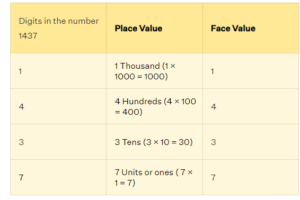Place Value and Face Value
The face value of a digit in any number is the digit itself. Whether the number is single-digit, double-digit, or any number, each digit has its face value. Let us understand this using the following examples.
Click here to Read more interesting case study based article on each TLS sub topic in my second website
- If 4 is the given number, the face value of 4 is 4, and the place value of 4 is also 4 (4 ones = 4 × 1 = 4).
- For a given number 78, the face value of 7 is 7 and its place value is 70 (7 tens = 7 × 10 = 70).
- For 52369, the face value of 3 is 3 while its place value is 300 (3 hundreds = 3 × 100 = 300).
Difference between Place Value and Face Value
Place value describes the position of a digit in a given number. On the other hand, face value represents the number itself.
Let us take an example of a number say, 1437. The table given below explains the difference between the place value and the face value of digits in this number.

Place Value Examples
Example 1: Write the place value of the underlined digit: 645
Solution:
Since 6 is in the hundreds place, the place value of 6 in 645 is 6 hundreds. This means the place value of 6 is expressed as 6 × 100 = 600.
Example 2: A number has 4 thousand, 7 hundreds, and 8 tens. What is the number?
Solution:
The place value of the following digits are:
4 thousands = 4,000
7 hundreds = 700
8 tens = 80
Adding these numbers together, we get: 4,000 + 700 + 80 = 4780. Therefore, the number is 4780.